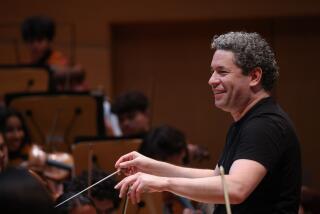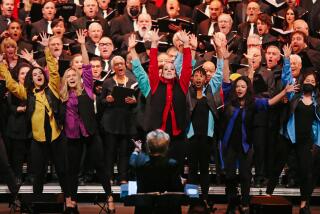MUSIC REVIEW : Chorale Scales Berlioz’s Mountain
COSTA MESA — It’s a news event simply when the Berlioz Requiem gets performed at all, no matter how. The demands it makes upon choir, orchestra, conductor and audience are huge. The forces it requires are Gargantuan. So is the courage.
Half the battle becomes just to get this mass of humanity to move as one through the uniquely Berliozean obstacle course. The other half is to make music out of it.
For the opening of its 38th season Saturday night at the Orange County Performing Arts Center, the Master Chorale of Orange County took on the 1837 masterpiece with the help of the Chapman University Choir and the Master Chorale Orchestra. Music director William Hall conducted the lot, well more than 300 in number.
This he accomplished (for the most part) with expert efficiency and bravado: Hall has never been known to cheat a climax, and the monumental ones here shook the rafters. His clear baton technique got everyone through the land mines, too, including the infamous “Tuba Mirum,” with its four brass choirs spread to the four corners playing at cross purposes to each other. (Saturday, Hall placed one brass group each stage left and right, one in the back right of the second balcony, one in the back left of the third balcony.)
He kept the choirs singing together and in balance. He shaped their lines consistently, coaxed nuance. Tenor John Nuzzo added a clear, fervent and ringing account of the Sanctus.
Was this the dream Requiem then? No, it was not. For one thing, Hall doesn’t seem to be much of an orchestral conductor--he becomes instantly more authoritative when he turns to his choir--and it showed on this occasion. The Master Chorale Orchestra could sound scruffy at times and, at a mere 70ish in number, with only six cellos and four double basses, fairly measly against the 250-strong vocal army.
Additionally, the dynamic nimbleness and rhythmic incisiveness called for by this music were often not answered, or answered only in a generalized way--in his double demand for agility and gigantic sound, Berlioz was truly unkind. The composer’s piquant, grotesque and innovative sonorities were largely obscured or subdued, some by the disparity between vocal and instrumental numbers, some by conductorial neglect.
Still, call it a solid Berlioz Requiem, a thrilling and impressive one in many ways. The ideal Requiem may remain in the mind’s ear, but Hall & Co.’s will do well in the meantime.
The concert opened with what seemed an unnecessary addition to the agenda (the Requiem took one hour and 24 minutes), Verdi’s 14-minute Stabat Mater (from “Quattro Pezzi Sacri”). Nevertheless, Hall led a richly intoned, shaded and muscle-flexing performance.
More to Read
The biggest entertainment stories
Get our big stories about Hollywood, film, television, music, arts, culture and more right in your inbox as soon as they publish.
You may occasionally receive promotional content from the Los Angeles Times.










